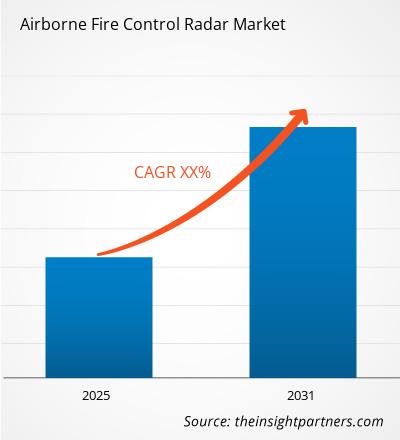MARKET OVERVIEW
Airborne fire control radar involves a high security and surveillance radar technology, which allows the defense forces to enhance their airborne military aviation infrastructure. The increasing adoption of automation of defense and surveillance radar systems, and rising defense budgets across developed as well as developing regions drive the airborne fire control radar market growth during the forecast period. Demand for airborne fire control radar is expected to grow substantially in near future.
MARKET SCOPE
The "Global Airborne Fire Control Radar Market Analysis to 2031" is a specialized and in-depth study of the aerospace and defense industry with a special focus on the global market trend analysis. The report aims to provide an overview of the airborne fire control radar market with detailed market segmentation by frequency band, application, and geography. The report provides key statistics on the market status of the leading airborne fire control radar market players and offers key trends and opportunities in the market.
MARKET SEGMENTATION
- Based on frequency band, the global airborne fire control radar market is segmented into S-band, X-band and Ku/K/Ka-band.
- On the basis of application, the market is segmented into Civil and Military.
MARKET DYNAMICS
Drivers:
- Growing military expenditure in numerous countries.
- Rapid technological advancements in radar technology.
Restraints:
- High capital investment may restrain the market growth in few developing countries
REGIONAL FRAMEWORK
The report provides a detailed overview of the industry including both qualitative and quantitative information. It provides an overview and forecast of the global market based on various segments. It also provides market size and forecast estimates from the year 2021 to 2031 with respect to five major regions, namely; North America, Europe, Asia-Pacific (APAC), and Rest of the World (RoW). The airborne fire control radar market by each region is later sub-segmented by respective countries and segments. The report covers the analysis and forecast of 17 countries globally along with the current trend and opportunities prevailing in the region.
The report analyzes factors affecting the market from both demand and supply side and further evaluates market dynamics affecting the market during the forecast period i.e., drivers, restraints, opportunities, and future trends. The report also provides exhaustive porter's five forces analysis affecting the airborne fire control radar market worldwide.
IMPACT OF COVID-19 ON AIRBORNE FIRE CONTROL RADAR MARKET
With growing military modernization programs, the production of airborne fire control radar systems was growing substantially before the pandemic began. But due to the pandemic of COVID-19, few countries' military spending was reduced during 2021 owing to increased expenses on oxygen cylinders, vaccines, and other healthcare facilities. In 2021, Argentina's military expenditure was US$ 3.13 billion which was reduced to US$ 2.97 billion in 2021. Such a decrease in the defense budget impacted the demand for airborne fire control radar systems to some extent. Temporary manufacturing shutdown, limited availability of raw material, restriction of the limited workforce and delay in scheduled deliveries have affected the production process negatively. With growing vaccination drives, the production process has started coming back to normalcy. The airborne fire control radar systems market is predicted to grow notably in the coming years.
MARKET PLAYERS
The report covers key developments in the airborne fire control radar market as organic and inorganic growth strategies. Various companies are focusing on organic growth strategies such as product launches, product approvals and others such as patents and events. Inorganic growth strategies activities witnessed in the market were acquisitions, and partnership & collaborations. These activities have paved way for the expansion of business and customer base of market players. The market payers from airborne fire control radar market are anticipated to lucrative growth opportunities in the future with the rising demand for airborne fire control radar in the global market.
The report also includes the profiles of key companies along with their SWOT analysis and market strategies in the airborne fire control radar market. In addition, the report focuses on leading industry players with information such as company profiles, components, and services offered, financial information of the last 3 years, the key development in the past five years.
- ASELSAN A..
- Bharat Electronics Limited (BEL)
- General Dynamics Mission Systems, Inc.
- Israel Aerospace Industries
- Leonardo S.p.A.
- Lockheed Martin Corporation
- Northrop Grumman Corporation
- Raytheon Technologies Corporation
- Saab AB
- Thales Group
Airborne Fire Control Radar Report Scope
| Report Attribute | Details |
|---|---|
| Market size in 2024 | US$ XX million |
| Market Size by 2031 | US$ XX Million |
| Global CAGR (2025 - 2031) | XX% |
| Historical Data | 2021-2023 |
| Forecast period | 2025-2031 |
| Segments Covered |
By Frequency Band
|
| Regions and Countries Covered | North America
|
| Market leaders and key company profiles |
- Historical Analysis (2 Years), Base Year, Forecast (7 Years) with CAGR
- PEST and SWOT Analysis
- Market Size Value / Volume - Global, Regional, Country
- Industry and Competitive Landscape
- Excel Dataset



Report Coverage
Revenue forecast, Company Analysis, Industry landscape, Growth factors, and Trends

Segment Covered
This text is related
to segments covered.

Regional Scope
North America, Europe, Asia Pacific, Middle East & Africa, South & Central America

Country Scope
This text is related
to country scope.
Trends and growth analysis reports related to Aerospace and Defense : READ MORE..
The List of Companies
1.ASELSAN A.S.
2.Bharat Electronics Limited (BEL)
3.General Dynamics Mission Systems, Inc.
4.Israel Aerospace Industries
5.Leonardo S.p.A.
6.Lockheed Martin Corporation
7.Northrop Grumman Corporation
8.Raytheon Technologies Corporation
9.Saab AB
10.Thales Group
1.ASELSAN A.S.
2.Bharat Electronics Limited (BEL)
3.General Dynamics Mission Systems, Inc.
4.Israel Aerospace Industries
5.Leonardo S.p.A.
6.Lockheed Martin Corporation
7.Northrop Grumman Corporation
8.Raytheon Technologies Corporation
9.Saab AB
10.Thales Group

 Get Free Sample For
Get Free Sample For